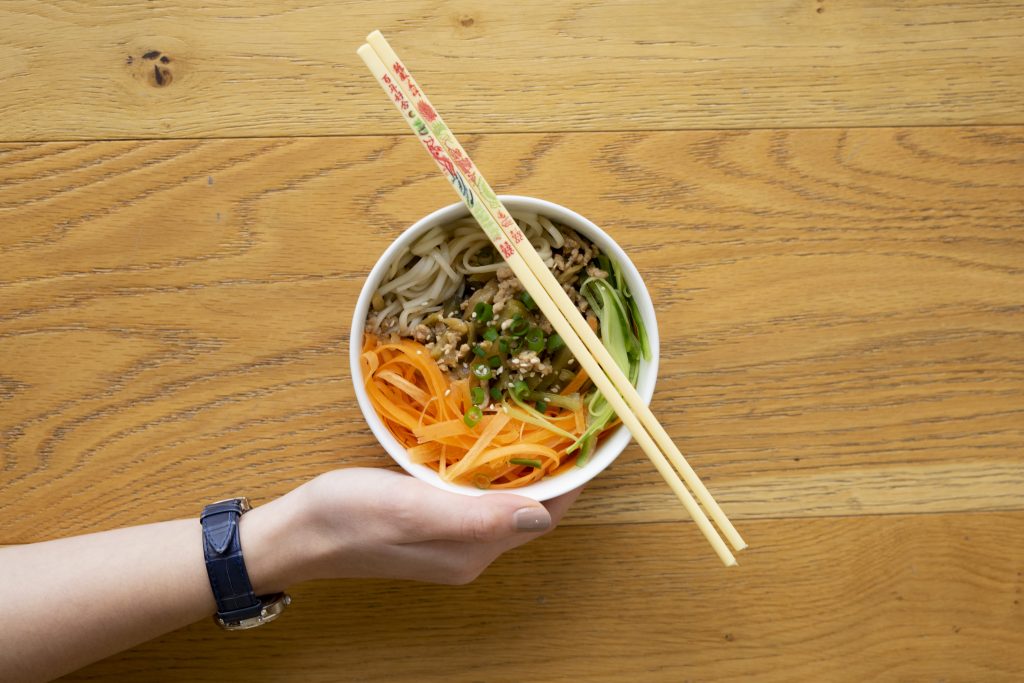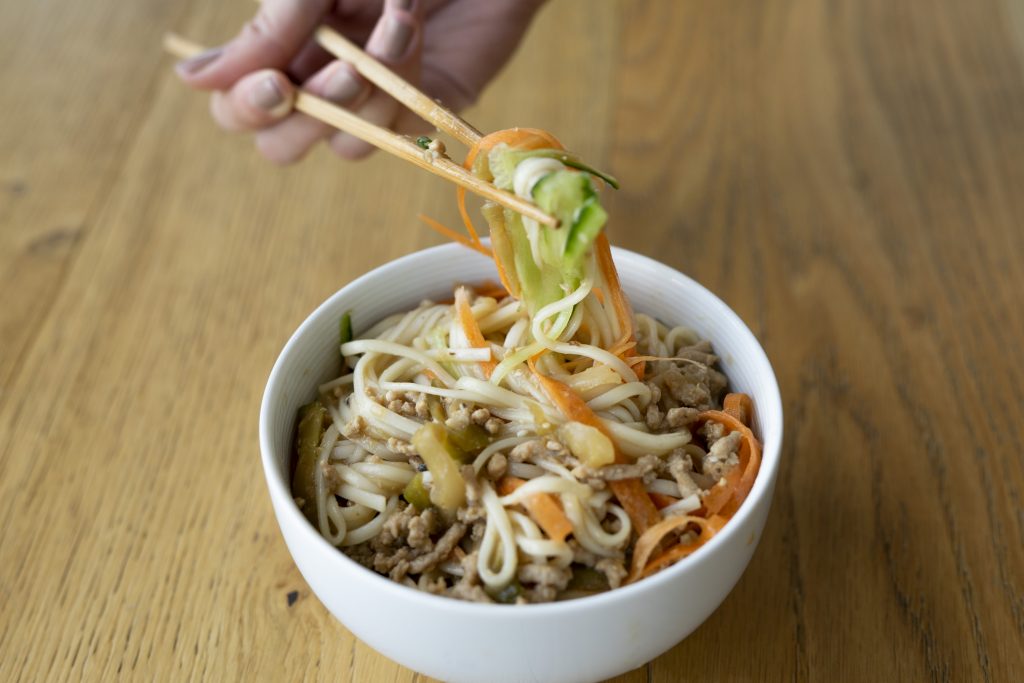
Growing up, we were incredibly lucky to have a mum who cooked our meals. She rarely asked for our help, but if she caught us hovering in the kitchen, she would walk us through the dish she was cooking with authority. We watched silently as she demonstrated the secret to poaching a whole chicken, dipping it briefly in an ice bath to create a glossy skin. These brief lessons would end with us scurrying away with a bit of dinner, a reward for our company.
In our household of five, there were two distinct menus: a lunch menu and a dinner menu. Lunch usually consisted of a single dish, ranging between anything from char siew noodles to chicken porridge, or Mum’s famous fried rice. The dinner menu, on the other hand, was more complex, made up of three dishes (two proteins and a vegetable dish), a large pot of soup, and paired with bowls of perfectly cooked Japanese short grain rice.
My sisters and I would eat lunch cross-legged in front of the TV, our school uniforms stuck to our skin from sweat, savouring both the food and the precious down time we had before having to return to our studies. Dinner was eaten as a family – grandparents included – around the dining table as we swapped stories from the day and listened to stories from the past (my grandmother has an arsenal of hilarious yet embarrassing stories of us when we were little). Since moving to Australia, mealtimes became moments to be savoured on my trips home.
With the travel ban in place, borders closed, and my biannual return home becoming less and less feasible, video calls, which were previously almost unheard of in our family, became a regular occurrence. My two sisters and I live separately, so the calls became a show-and-tell of sorts where we’d show off our dinner – or breakfast, for my sister in Turkey – or our latest baked goods to the rest of the family. Food became our sanctuary to distract ourselves from the flaming dumpster fire that is 2020. We would help each other troubleshoot recipes (my choux pastry needed more time in the oven, my sister’s scallion pancakes needed a longer rest), exchanged recipes and caught each other up on the latest news in the food industry (my father gave us a long lecture regarding the impact COVID-19 had on the global food supply chain). Food has always been what my family bonded over, so it was no surprise that food was what brought us closer together during a global pandemic.
As the weeks at home dragged on, cooking and baking became my only escape. Making dinner grew into a sacred activity. I would allow myself to block out the chaos and sadness in the world and focus on creating a plate of nutritious and delicious food. My usual pre-pandemic menu of simple 30-minute meals was exchanged for pots of stock simmering away on the stove for hours on end and proteins that needed hours to marinate. Checking in on the soup and stirring the marinade became my go-to excuses to indulge in a one-minute study break. After all, time was something I had in abundance since I no longer had to commute back and forth from university. Even after doing all the assigned work, I still found myself with several hours to kill. I was thus cooking a lot more than usual, not only because I had to cook all three of my meals (to stay economical), but because I found comfort in being in the kitchen. I was in my element dicing onions, finely chopping ginger and balancing sauces. Maybe it was all the Binging with Babbish videos I had been consuming to maintain favourable serotonin levels, or maybe it was because I needed a hobby that was relatively time consuming, practical and bore some sort of final product that I could assess. Either way, I spent my days in the kitchen, running away from my responsibilities.
My isolation culinary journey started out with gusto: I perfected the flaky crispiness of scallion pancakes; I made saucy, hearty bowls of pasta for dinner; experimented with making bread loaves; and fired up a batch of mushroom and tofu bulgogi. But as delicious as it was, it wasn’t sustainable. Having to think of creative ways to feed myself was mentally draining, and as much as I loved cooking, I hated having to figure out my weekly menu – because unlike my mother, I lacked an arsenal of dishes I could make without looking up a recipe and the mental dexterity to link ingredients with dishes. My mother would go to the wet market for inspiration, whereas you would most likely find me aimlessly wandering the aisles of Coles unless I had a meal plan and its accompanying grocery list. Moreover, as scrumptious as these foods were, they lacked a key component that I was sorely craving: familiarity.
In the five years I have lived away from home, I never felt a strong yearning to return; it took a global pandemic, but I finally felt homesick. I wanted to cook foods that transported me home and connected with my family, which is currently scattered across the globe. I needed foods that brought comfort, dishes that lifted the anxiety and disorder that weighed heavy around me. I wanted Cantonese-style steamed fish with soy sauce and ginger, clay-pot chicken rice, steamed egg with garlic-scallion oil, and my favourite lunch dish, Mum’s version of zha jiang mian.
One evening, over text, I finally got around to asking my mum for her zha jiang mian recipe. It had been a particularly tough week and I needed my favourite lunch menu item to ease the stress. True to her ways, she sent me a short essay detailing to a tee the instructions for this dish, followed by several short voice messages explaining the recipe. Like many Asian home cooks, she never measures her ingredients. She would tell me to agak-agak (estimate) the amount of soy sauce needed. “You know me, I don’t measure, I just taste and adjust until it’s correct,” her voice memo announced.
I called my younger sister over and recreated the dish that weekend. She acted as my sous-chef, marinating the meat and rising the vegetables. She chastised me for not having any white pepper, claiming that I “wasn’t Chinese” if I didn’t have any, and I told her off for refusing to rinse the vegetables (she claims it rinses away all the flavour). Neither of us have witnessed our mum make this dish; we only ever knew it in its finished form. Making it from scratch felt like I was uncovering a secret from my childhood, one that took 21 years and a global pandemic to unlock. My sister voiced her approval of our creation as she took liberal mouthfuls of the noodles.
We sent a photo of the finished dish to the family group chat, and it was met with applause and a comment from my mum that the sauce was not thick enough (it needed to add more cornstarch). What we made that day wasn’t a perfect replica of what my mother used to make us, but then again, she has a gift with food that none of us could ever come close to. It didn’t matter though, because as I dug into the zha jiang mian, I was 15 again, in my school uniform, sitting crossed legged at the coffee table, eating lunch in the sweltering heat.


